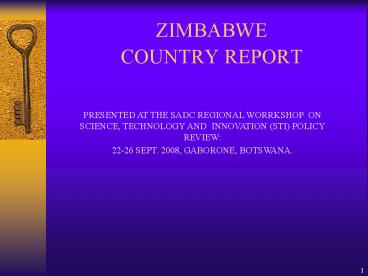1 - PowerPoint PPT Presentation
1 / 18
Title: 1
1
ZIMBABWECOUNTRY REPORT
PRESENTED AT THE SADC REGIONAL WORRKSHOP ON
SCIENCE, TECHNOLOGY AND INNOVATION (STI) POLICY
REVIEW 22-26 SEPT. 2008, GABORONE, BOTSWANA.
2
ByMinistry of Science and Technology
DevelopmentZIMBABWE
S C MadzingaDirector, Policy Development and
Management
3
PRESENTATION SUMMARY
- 1. Introduction
- 2. Background
- 3. Zimbabwes S T Policy
- 4. ST Policy
- Implementation Strategy
- - Creation of an enabling
- environment
- - Institutions
- 5.ST Policy Implementation StatusAchievements
- - Policies
- - Programmes
- 6. Challenges
- 7. STI Policy Development Needs
- 8. Policies in Progress
- 9 . Concluding remarks
4
1. INTRODUCTION.
- The Government of Zimbabwe, like others in
SADC , is acutely aware of the critical role S
T plays in socio-economic development. Thus in
2001 the Government of Zimbabwe adopted the
National S T Policy as a tool with which to
expedite sustainable industrialization of the
economy.
5
2. BACKGROUND
- 2.1 History
- Efforts at establishing a national System of
Innovation date as far back as the1950s. - Research Act (Ch. 336) of 1959 established the
Research Foundation of Rhodesia - 1986, the Scientific and Technological Research
Act (CH. 1022)replaced the Research Act 1959. - Research Act Amended in 1988 and 1998 to include
Bio-safety matters.
6
2. BACKGROUND CONT.
- 2.2 Establishment of the MSTD
- 1967 establishment of the Scientific Liaison
Office in the Prime Ministers Office-Rhodesia - 1980- establishment of SLO in Prime Ministers
Office in independent Zimbabwe - 2002- establishment of a Department of ST
Development - 2005- establishment of MSTD
7
2. BACKGROUND CONT.
- 2.3 The MSTD
- Vision To be a facilitator for a Science and
Technology driven economy. - Mission To strategically coordinate and promote
the systematic development and application of ST
in support of national development through
effective engagement of public and private sector
partners. - Overall Function To implement the ST Policy
8
3. ZIMBABWES ST POLICY
- The overall objectives of the ST Policy are
to promote - Rapid sustainable industrialization through RD
for value addition and import substitution - The provision of adequate shelter through
application of appropriate technologies - The achievement of food security through RD and
application of appropriate technologies - Sound health delivery systems through RD in
indigenous and modern medicine - The provision of sufficient energy resources
through RD geared towards energy generation and
conservation - Environmental preservation and sustainable
utilisation of our biodiversity
9
4. IMPLEMENTATION STRATEGY
4.1. Creation Of An Enabling Environment
- Coordination
- Policy Frameworks formulation
- Regulatory Frameworks
- RD promotion
- Networking and Collaboration
- Benchmarking
- Monitoring and Evaluation
- Set up a database.
10
4. IMPLEMENTATION STRATEGY
4.2. The Institutions
- The MSTD
- The RCZ
- SIRDC
- NBA
- ZARNet
- Provincial ST Dev Committees
- Finealt Pvt. Ltd.
- Line ministries
- Gov. RD Institutions
- Pvt. RD Institutions
- ZAI
- ZAS
- ICT Task Force
11
5. S T POLICY IMPLEMENTATION STATUS
Achievements
- 5.1. Policies
- ST Policy Launch 2002
- Establishment of Department of ST Development
2002 - Establishment of MSTD 2005
- Establishment of Provincial ST Development
Committees 2004-2005 - Sectoral ST Policy implement. review 2005
12
5. S T POLICY IMPLEMENTATION STATUS
Achievements
5.1. Policies Cont
- Biotechnology Policy Development 2005
- National Biotechnology Act 2006
- E-readiness Survey 2005
- ICT Policy Launch 2007
- Regional International collaboration
- SADC ST Framework and Protocol
- MOU with South Africa Nov. 2007
- Membership of Intn. Orgs.
13
5.2. Programmes
5. S T POLICY IMPLEMENTATION STATUS
Achievements
- ST Popularisation Support
- Exhibitions, ZITF, HAS, SLATE,
- Provincial Exhibitions
- Youths in Science
- Women in Science
- Schools Computerization
- I C Fund
- Biodiesel Project
- Participation in regional activities
- STI-ACT 2007
14
6. CHALLENGES
- Capacity development-
- Human, Equipment, Infrastructure
- Brain drain
- Funding
- Cross-cutting nature of STI
15
7. STI POLICY DEVELOPMENT NEEDS
- STI Policy Review
- Capacity Development
- STI Indicators Development
- ASTCPA Implementation - Centres of Excellence
- NSI Framework
- Technology Transfer and management
- ICT Infrastructure Dev
- STI Experts Database
- Strengthening of External collaboration
- Sector by sector ST needs analysis
- Funding 1 GDP
16
8. POLICIES IN PROGRESS
- MSTD Restructuring
- STI Bill formulation
- ICT Bill formulation
- I P Policy Formulation
- Collaboration with UNESCO, COMESA
- MOUs with countries such as-
- India, Malawi, Algeria, Iran, Pakistan
17
9. CONCLUDING REMARKS
- Zimbabwes S T situation shows that there
are a number of challenges and needs that require
the kind of sharing and exchange of views and
ideas as is happening at this workshop if they
are to be overcome. We therefore thank UNESCO and
the Government of Botswana for organising this
workshop.
18
THANK YOU































